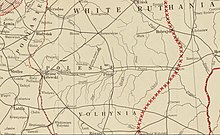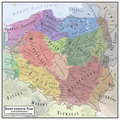Polesia
Polesia
Палессе • Полісся Polesie | |
|---|---|
Natural and historical region | |
| |
 Polesian Lowland marked in dark green | |
| Countries | Belarus, Poland, and Ukraine |
| Largest city | Homel |
Polesia, also called Polissia, Polesie, or Polesye,[a] is a natural (geographic) and historical region in Eastern Europe within the bigger East European Plain, including part of eastern Poland and the Belarus–Ukraine border region.[2] This region should not be confused with parts of Russia also traditionally called "Polesie".
Extent
[edit]One of the largest forest areas on the continent, Polesia is located in the southwestern part of the Eastern-European Lowland, the Polesian Lowland. On the western side, Polesia originates at the crossing of the Bug River valley in Poland and the Pripyat River valley of Western Ukraine.[3] The westernmost part of the region, located in Poland and around Brest, Belarus, historically also formed part of the historic region of Podlachia, and is also referred to as such. The modern Polish part was not considered part of Polesia by the late 19th-century Geographical Dictionary of the Kingdom of Poland, which defined the region as roughly a triangle between the cities of Brest in the west, Mogilev in the northeast and Kyiv in the southeast.[4] The swampy areas of central Polesia are known as the Pinsk Marshes (after the major local city of Pinsk). Large parts of the region were contaminated after the Chernobyl disaster and the region now includes the Chernobyl Exclusion Zone and Polesie State Radioecological Reserve, named after the region.
-
Polesie within Belarus
-
Geographic regions of Polesie (Polissia) within Ukraine
-
Polesia (Polesie) and other historical lands of Poland against the background of modern administrative borders (names in Polish)
Name
[edit]The names Polesia/Polissia/Polesye, etc. are constructed from the East Slavic root les 'forest', and the prefix po-, which in the meaning of 'on, by, along' is used to create place names.[5] Inhabitants of Polesia are called Polishchuks.
History
[edit]
In ancient times, the areas of today's western and west-central Polesia were inhabited by the people of the Milograd culture, the Neuri.[6]
In the late Middle Ages Polesia became part of the Grand Duchy of Lithuania, following it into the Polish–Lithuanian Commonwealth (1569). It was annexed by Russia in the late-18th-century Partitions of Poland. Polesia was largely part of Poland from 1921 to 1939, when the country's largest province, the Polesie Voivodeship, bore that name,[2] with the eastern part forming part of the Byelorussian SSR, within which the Polesia Region was created in 1938. From 1931 to 1944, it was explicitly mentioned as constituent part of the short-lived (Byzantine Rite) Ukrainian Catholic Apostolic Exarchate of Volhynia, Polesia and Pidliashia.[7]

Following the 1939 invasion of Poland, most of the region was under Soviet occupation, with the western outskirts under German occupation until 1941, and then the entire region, including the pre-war Soviet-controlled part, was under German occupation until 1943–1944. Since the end of World War II, the region has encompassed areas in eastern Poland, southern Belarus, and northwestern Ukraine.[citation needed]
Geography
[edit]Polesia is a marshy region lining the Pripyat River (Pripyat Marshes) in Southern Belarus (Brest, Pinsk, Kalinkavichy, Gomel), Northern Ukraine (in the Volyn, Rivne, Zhytomyr, Kyiv and Chernihiv Oblasts), and partly in Poland (Lublin). It is a flatland within the drainage basins of the Western Bug and Prypyat rivers. The two rivers are connected by the Dnieper-Bug Canal, built during the reign of Stanislaus II of Poland, the last king of the Polish–Lithuanian Commonwealth.
Notable tributaries of the Pripyat are the Horyn, Stokhid, Styr, Ptsich, and Yaselda rivers. The largest towns in the Pripyat basin are Pinsk, Stolin, Davyd-Haradok. Huge marshes were reclaimed from the 1960s to the 1980s for farmland.[clarification needed]
The region is subdivided into several subregions among which are:[citation needed]
- Poland
- Ukraine
- Volhynian Polissia
- Little Polissia, a.ka. Lviv Polissia
- Zhytomyr Polissia
- Kyiv Polissia
- Chernihiv Polissia
- Novhorod-Siverskyi Polissia
- Belarus
- Brest Paliessie
- Zaharodzie
- Prypiat Paliessie
- Mazyr Paliessie
- Homiel Paliessie
According to the late 19th-century Geographical Dictionary of the Kingdom of Poland Polesie was divided into Northern Polesia, itself divided into Upper Polesia or Pinsk Polesia and Lower Polesia or Mazyr Polesia, and Southern Polesia, itself divided into Volhynian Polesia (overlapping northern Volhynia) and Drevlian Polesia.[4]
Chernobyl disaster
[edit]This region suffered severely from the Chernobyl disaster. Huge areas were polluted by radioactive elements. The most polluted part includes the Chernobyl Exclusion Zone and the adjacent Polesie State Radioecological Reserve. Some other areas in the region are considered unsuitable for living as well.[8]
Tourism
[edit]The Polish part of the region includes the Polesie National Park (Poleski Park Narodowy), established 1990, which covers an area of 97.6 square kilometres (37.7 sq mi). This and a wider area adjoining it (up to the Ukrainian border) make up the UNESCO-designated West Polesie Biosphere Reserve, which borders a similar reserve (the Shatskiy Biosphere Reserve) on the Ukrainian side. There is also a protected area called Pribuzhskoye-Polesie in the Belarusian part of the region.
The wooden architecture structures in the region were added to the UNESCO World Heritage Tentative List on 30 January 2004 in the Cultural category.[9]
See also
[edit]- Museum of Ukrainian home icons
- Radomysl Castle
- Swamps of Belarus
- Western Polesie
- Polesian Saddle, large tectonic structure in southwestern Belarus
There are areas in Russia traditionally called Polesie (Russian: Полесье) as well. However there the origin of the term is different: historically it referred to transitional areas from woodless fields to densely wooded territory.[10]
- Oryol-Kaluga Polesie straddling the border of Oryol and Kaluga Oblasts
- Bryansk-Zhizdra Polesie (Брянско-Жиздринское Полесье) is a forest area with about 1% swamps within the slightly elevated outwash plain in the south-west of Kaluga Oblast between rivers Resseta and Vytebet.[11][12]
Notes
[edit]- ^
- Belarusian: Палессе, romanized: Palyessye [paˈlʲesʲːe]
- Ukrainian: Полісся, romanized: Polissia [poˈlʲisʲːɐ]
- Polish: Polesie [pɔˈlɛɕɛ] ⓘ
- Russian: Полесье, romanized: Polesye
- Latin: Tractus Polesiensis[1]
References
[edit]- ^ Michał Baliński, Tymoteusz Lipiński, Starożytna Polska: pod względem historycznym, jeograficznym i statystycznym, Volume 3, 1846, p. 834
- ^ a b "Polesie". University at Buffalo, New York. Polish Academic Information Center. Archived from the original on 7 September 2016. Retrieved 2 May 2014.
- ^ Alicja Breymeyer. "Presentation of West Polesie Transboundary Biosphere Reserve (Belarus/Poland/Ukraine)". Nomination Form prepared in Warsaw, Kyiv and Minsk by National UNESCO-MAB Committees, and introduced to UNESCO in a May 2007 Nomination. West Polesie.org. Archived from the original on 2 May 2016. Retrieved 2 May 2014.
- ^ a b Słownik geograficzny Królestwa Polskiego i innych krajów słowiańskich, Tom VIII (in Polish). Warszawa. 1887. p. 579-587.
{{cite book}}: CS1 maint: location missing publisher (link) - ^ Compare Mould, R. F. (2000). Chernobyl Record: The Definitive History of the Chernobyl Catastrophe. Bristol, UK: Institute of Physics Publishing. ISBN 0-7503-0670-X.
- ^ David Asheri, Alan B. Lloyd, Aldo Corcella, A commentary on Herodotus Books I-IV , edited by Oswyn Murray, Alfonso Moreno, Oxford University Press, Oxford 2007, p. 589
- ^ "Apostolic Exarchate of Volhynia, Polesia and Pidliashia (Ukrainian Rite)". GCatholic.
- ^ "Zoning of radioactively contaminated territory of Ukraine according to actual regulations". ICRIN. 2004. Archived from the original on 18 February 2013. Retrieved 25 April 2012.
- ^ "Worship wooden architecture (17th -18th centuries) in Polesye - UNESCO World Heritage Centre". Whc.unesco.org. 30 January 2004. Retrieved 13 January 2013.
- ^ . Brockhaus and Efron Encyclopedic Dictionary (in Russian). 1906.
- ^ Брянско-Жиздринское Полесье
- ^ ecology.gpntb.ru > Экология в библиотечном мире > Центральный федеральный округ > Калужская область
Further reading
[edit]- Пазинич В., Походження Поліських озер та параболічних дюн (Ukrainian)/Пазинич В.Г., Происхождение Полесских озер и параболических дюн (Russian)
- Zeitschrift für Ostmitteleuropaforschung, Heft 3/2019: Polesia: Modernity in the Marshlands. Interventions and Transformations at the European Periphery from the Nineteenth to the Twenty-first Century Online: Bd. 68 Nr. 3 (2019): Polesia: Modernity in the Marshlands. Interventions and Transformations at the European Periphery from the Nineteenth to the Twenty-first Century | Zeitschrift für Ostmitteleuropa-Forschung
- "Polesie (pp. 579-587)". Geographical Dictionary of the Kingdom of Poland (in Polish). 8. Warszawa: Kasa im. Józefa Mianowskiego. 1887. p. 579.
External links
[edit]- The Official Site of Radomysl Castle Archived 14 August 2020 at the Wayback Machine
- Polisia at the Encyclopedia of Ukraine
- Origin of Polesie lakes and parabolic dunes
- Save Polesia - E40 waterway would destroy biodiversity hotspots and key protected areas, says new report
- Polesia | Wilderness without borders: Protecting one of Europe's largest natural landscapes - Frankfurt Zoological Society






